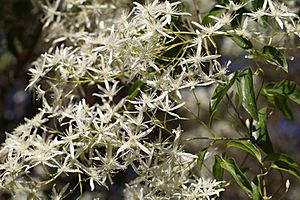Headache vine facts for kids
Quick facts for kids Headache vine |
|
|---|---|
 |
|
| Scientific classification | |
| Synonyms | |
|
Clematis stenosepala R.Br. ex DC. |
The Clematis glycinoides, often called the headache vine, is a climbing plant. It belongs to the Ranunculaceae family, which includes buttercups. You can find this vine growing in eastern Australia and also in New Caledonia.
Contents
Why is it Called Headache Vine?
A scientist named Augustin Pyramus de Candolle first described this plant in 1817. The plant gets its common name, "headache vine," from an old folk remedy. People used to think that sniffing the crushed leaves could help with headaches.
The plant's fumes are very strong and can be irritating. People who tried this remedy said the powerful smell made their eyes water and their noses tingle. This strong feeling was so distracting that they would quickly forget about their original headache!
There are two main types, or varieties, of this plant: C. glycinoides glycinoides and C. glycinoides submutica.
What Does Headache Vine Look Like?
The headache vine is a woody plant that can climb very high, sometimes up to 15 meters (about 49 feet) long. Its leaves are shaped like spears or oblongs. They are usually between 1.5 and 12 centimeters (0.6 to 4.7 inches) long and 1 to 8 centimeters (0.4 to 3.1 inches) wide.
The plant produces creamy-white flowers. These flowers usually appear from July to December, but you'll see the most of them in September. Interestingly, this plant is "dioecious." This means that individual plants have either male flowers or female flowers, but not both.
After the flowers, the plant forms unique seedheads. These seedheads have several feathery "tails" that can be up to 6 centimeters (about 2.4 inches) long.
Where Does Headache Vine Grow?
You can find Clematis glycinoides in several parts of Australia, including Queensland, New South Wales, and Victoria. It likes to grow in different types of environments. These include woodlands, forests, and even rainforests.
This vine prefers soils that drain water well, such as those made of basalt, limestone, shale, or sandstone. It often grows under taller trees in open forests. Some of these trees include the grey myrtle, grey ironbark, and manna gum. It also grows in floodplain forests with trees like cabbage gum and broad-leaved apple.
Honeybees are known to visit the flowers of the headache vine.
Growing Headache Vine
If you want to grow headache vine, it's good to know that it might not grow as fast or as strong as some other Clematis plants. It needs moist conditions to grow well. People often like to grow it because its white flowers are quite pretty.

